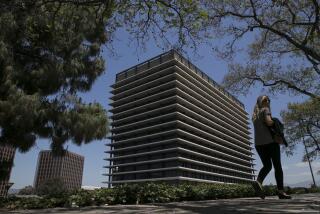Op-Ed: DWP’s rate increase plan just isn’t big enough
The Los Angeles Department of Water and Power recently proposed a water rate hike. If approved by the City Council, the average DWP customer will see an increase in water rates of about 3.8% each year for five years, with heavy users charged more for additional costs related to delivery, treatment and the construction of supply facilities. Ultimately, these proposed changes will add roughly $1.2 billion to DWP’s coffers.
A cost-of-service-based tiered rate structure will send a strong and legally defensible signal to water wasters during California’s worse drought in more than a century. The total amount raised, though, is not enough. If Mayor Eric Garcetti wants to realize his ambitious, big-picture water management agenda, we must all pay more.
------------
FOR THE RECORD:
Water rates: In an op-ed Wednesday about DWP water rate increases, an L.A. department was misnamed. It is Recreation and Parks, not Parks and Recreation.
------------
L.A.’s recent conservation success has been driven by investments in lawn replacement, changes in consumer behavior and major water-saving efforts from city agencies including Parks and Recreation, General Services and Street Services. The mayor, however, doesn’t just want Angelenos to conserve water; he has said he wants to reduce imported water 50% by 2025 — a worthy goal that would require nothing less than a transformation of the city’s water supply portfolio. In the last two years, L.A. has imported 89% of its water from sources more than 200 miles away, including the Eastern Sierra, the Sacramento-San Joaquin River Delta and the Colorado River.
The DWP released a study in June indicating that there is potential for an additional 100,000 to 200,000 acre-feet of supply (20% to 40% of the city’s current needs) from captured stormwater. The long-term potential from L.A.’s wastewater treatment plants also is in the 100,000 to 200,000 acre-feet range. Groundwater from the eastern San Fernando Valley and other sources could contribute in the same ballpark.
In theory, Garcetti could meet and actually exceed his 50% target. But turning potential into reality will cost billions of dollars.
Planned water recycling, and groundwater treatment and distribution facilities in the San Fernando Valley, combine for more than a $1-billion price tag alone; add on $500 million for needed stormwater capture projects.
Proposition 1 state water bond funds may help to some extent, especially on the groundwater treatment project. But this one-time cash infusion provides just a fraction of the capital costs needed to build new infrastructure. And bond funds cannot legally be used for ongoing operation or maintenance. Only ratepayer funds can be used for those purposes.
The city, besides, has to do more than invest in new projects; it also must improve existing infrastructure. Last year’s spectacular water main rupture near UCLA, which flooded Pauley Pavilion with about 20 million gallons of potable water, was a high-profile example of the need for maintenance and repair.
The DWP estimates that 435 miles of its 6,700-mile distribution system is in serious need of replacement. Switching out these pipes by 2025 will cost $1.3 billion. But the DWP will need yet more money to replace the hundreds of miles of pipe that are between 70 and 110 years old, as well as all of the pipes that are seismically vulnerable. In addition, the DWP must invest significantly in new or upgraded pumping systems, valves, drinking-water treatment facilities, fire hydrants, tanks and reservoirs as part of the Water Infrastructure Plan.
To even have a chance at achieving the mayor’s water self-sufficiency and infrastructure improvement goals, the DWP probably would need to impose at least a 6%, rather than a 3.8%, rate increase. This would generate an additional $650 million in revenue over five years that could help make the city more self-sufficient.
A 6% hike may seem like a lot, but it is less than the Metropolitan Water District’s average annual rate increase of about 7% over the last decade. Los Angeles’ rates would remain highly competitive and, in fact, result in water bills that are still among the lowest in the region.
Los Angeles has been through a water infrastructure crisis before. In the 1980s, Santa Monica Bay was one of the most polluted bodies of water in the nation because of a sewage treatment and distribution system that was arcane and in a state of chronic disrepair. Los Angeles ratepayers made multibillion-dollar investments that led to a healthier bay and a radically reduced sewage spill rate per mile.
The city can meet its ambitious water supply goals, but it must first ask ratepayers to invest in a more sustainable future.
Mark Gold is the associate vice chancellor of environment and sustainability at UCLA.
Follow the Opinion section on Twitter @latimesopinion and Facebook
More to Read
A cure for the common opinion
Get thought-provoking perspectives with our weekly newsletter.
You may occasionally receive promotional content from the Los Angeles Times.










